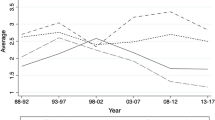Abstract
Over the past century, criminology has evolved as both an applied and increasingly recognized scientific discipline. Although criminology has experienced a number of ideological shifts in focus, the discipline is now poised to effectively combine both of its purposes, namely the ongoing search for the causes of crime and advancing the use of empirical research in policy and practice decisions. One of the most promising best practices in this simultaneous pursuit is researcher and policymaker/practitioner partnerships. This paper traces the “making a difference” movement in criminology since 2000. It begins with an assessment of the rise of and resistance to the making a difference movement, followed by a discussion of some of the challenges and prospects for criminologists in their efforts to apply research to policy and practice through researcher and policymaker/practitioner partnerships. The paper concludes with discussion of the future potential of researcher and policymaker/practitioner partnerships in successfully confronting our major crime and criminal justice system challenges.
Similar content being viewed by others
References
Bales, W. D. & Lockwood, K. (2018). Email Correspondence.
Baumer, E. P. (2015). Member perspectives. The Criminologist, 40(3), 8.
Blomberg, T. G., Bales, W. D., Mann, K., Piquero, A. R., & Berk, R. A. (2011). Incarceration, education and transition from delinquency. Journal of Criminal Justice, 39(4), 355–365.
Blomberg, T. G., Bales, W. D., & Piquero, A. R. (2012). Is educational achievement a turning point for incarcerated delinquents across race and sex? Journal of Youth and Adolescence., 41(2), 202–216.
Blomberg, T. G., Brancale, J., & Mann, K. (2013). Seeking causality in a world of contingency: Criminology, research and public policy. Criminology and Public Policy, 12(4), 571–584.
Blomberg, T. G. (2018). Effectively Confronting School Shootings: It’s More Than Guns. Op-ed. Orlando Sun Sentinel.
Burawoy, M. (2005). For public sociology: 2004 presidential address. American Sociological Review, 70, 4–28.
Cloward, R. A. & Ohlin, L. (1960). Delinquency and Opportunity. Glencoe, IL: Free Press.
Cohen, A. K. (1955). Delinquent boys. Glencoe, IL: Free Press.
Elster, J. (1991). Arguing and bargaining in two constituent assemblies: The Storrs lectures, Yale Law School.
Greenwald, M. (2018). Email Correspondence.
Hanson, K. M. (2018). Email Correspondence.
Jeffery, C. R. (1977). Crime prevention through environmental design. Beverly Hills, CA: Sage Publications.
Katz, J. (1988). Seductions of crime: Moral and sensual attractions in doing evil. New York: Basic Books.
Mears, D. P. (2013). Supermax prisons: The policy and the evidence. Criminology and Public Policy, 12(4), 681–719.
Merton, R. K. (1938). Social structure and anomie. American Sociological Review, 3, 672–682.
Miller, W. B. (1958). Lower-class culture as a generating milieu of gang delinquency. Journal of Social Issues, 14(3), 5–19.
Morris, Z. S., Woodings, S., & Grant, J. (2011). The answer is 17 years, what is the question: Understanding time lags in translational research. JR Soc Med., 104, 510–520.
National Institute of Justice. (2005a). Establishing and sustaining law enforcement-researcher partnerships: Guide for researchers. Washington, DC: U.S. Department of Justice.
National Institute of Justice. (2005b). Establishing and sustaining law enforcement- researcher partnerships: Guide for leaders. Washington, DC: U.S. Department of Justice.
National Institute of Justice (2018). Projects funded by NIJ Awards. https://nij.gov/funding/awards. Accessed 12 June 2018.
Park, R. E., & Burgess, E. W. (1921). Introduction to the science of sociology. Chicago: The University of Chicago Press.
Rein, M., & Winship, C. (2000). The dangers of “strong” causal reasoning: Root causes, social science, and Poverty policy. In J. Bradshaw & R. Sainsbury (Eds.), Experiencing poverty. Aldershot: Ashgate.
Spivak, H. (2018). Researcher- practitioner partnerships. Remarks at the innovations suite researcher- practitioner fellows academy. School of Criminal Justice, Michigan State University.
Sutherland, E. A. (1934). Principals of criminology. Chicago, Philadelphia: J.B. Lippincott Company.
Tittle, C. R. (2004). The arrogance of public sociology. Social Forces, 82, 1639–1643.
Wellford, C. F. (2009). Criminologists should stop whining about their impact on policy and practice. In N. A. Frost, J. D. Frelich, & T. R. Clear (Eds.), Contemporary Issues in Criminal Justice Policy: Policy Proposals from the American Society of Criminology Conference. Belmont, CA: Wadsworth.
Author information
Authors and Affiliations
Corresponding author
Additional information
Publisher’s Note
Springer Nature remains neutral with regard to jurisdictional claims in published maps and institutional affiliations.
Prepared for Presentation at the 2018 Southern Criminal Justice Association Conference, Pensacola, FL.
Appendices
Appendix I
Appendix II
Rights and permissions
About this article
Cite this article
Blomberg, T.G. Making a Difference in Criminology: Past, Present, and Future. Am J Crim Just 44, 670–688 (2019). https://doi.org/10.1007/s12103-019-09484-6
Received:
Accepted:
Published:
Issue Date:
DOI: https://doi.org/10.1007/s12103-019-09484-6




